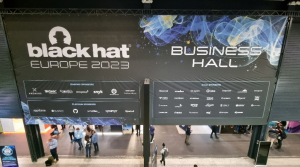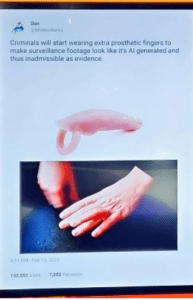CTO Insights December Newsletter – black hat Europe Special
The end of the year is quickly approaching and of course, your mailbox will be full of lookbacks and look-forwards, so I’ll save you one more by not doing any of that here. Instead, I thought I’d share with you some of my findings from my trip last week to black hat Europe in London (Dec 4th– 7th), now that’s much more fun, isn’t it?
The sessions
As it turned out I didn’t get a chance to do as many sessions as I would have liked, but the ones I did were interesting.
The threat of DeepFakes
I’ve spoken with a few industry experts on this topic this year and it’s going to be a huge challenge. This year has seen the commoditisation of Generative AI. This has created opportunities for businesses to find new ways to innovate, but it has also introduced new ways to innovate for cybercriminals. If you think about some of the uses of this tech, we already see from Instagram to Zoom, the ability to, in real-time, add filters, change the look of someone, and add backgrounds, all in an app at the click of a button. Cybercriminals are similarly using these accessible tools to carry out more innovative attacks. For example, companies such as resemble.ai which allow for speech creation are being used to try to carry out attacks against either voice security or to try to con an individual into engaging in a conversation. This type of attack is very difficult to recognise and stop and shows the scale of the challenge. There is little by way of technology that can tackle this currently, so awareness and education are crucial in trying to tackle it, knowing it’s a risk and looking at how to recognise it is essential. One good but of advice here was to remember some of the basics of cybersecurity if you are not expecting it then treat it as suspicious.
As a little addition to this, I grabbed this screenshot of something that raised a smile. It shows how creative criminals can be! Here using fake fingers to come up with an AI defence in court, technology eh!
Threat trends
It’s always interesting to understand where threats are coming from. Threats continue to develop across a broad spectrum of areas. There were a few interesting statistics I picked up during my time at the event, that should help to provide us with some focus on future threat vectors.
API-based attacks – There has been a doubling of cyber-attacks on APIs in the past 12 months. This makes sense as you look at our increased demand for integration and automation between platforms. In many instances, we no longer consider solutions if they don’t “publish their APIs”. However, that presents a potentially significant risk, with unsecured APIs are great route for a cyber attacker. Luckily this is an increasing number of API security tools available in the market, and their adoption can deliver high value. But it is not yet a table stake for many as we review our security options.
Ransomware – continues to dominate, with some shocking statistics shared from various vendors, this included a 143% growth in zero-day attack victims and a 42% increase in attacks on manufacturing. A rapidly evolving space to try to tackle this challenge is network micro-segmentation. This is usually based on software-defined policies with extremely granular controls allowing for context-based segmentation. This has two potential benefits, firstly it builds new security boundaries into your network environment, and in the event of an attack, it can more effectively reduce the “blast” from an attack, by limiting how much lateral movement an attacker can gain from a compromised machine.
DDoS attack growth – this was an interesting area, almost like welcoming back an old friend, while basic as an attack method it can be hugely effective in reducing access to systems and services. Threat actors have recognised this with growth in DDoS attacks across a variety of sectors including manufacturing and financial services. Stopping these attacks can be difficult, but there are technology shifts to help try to reduce the impact of DOS attacks. This includes architecturally building DNS resilience with Edge Platforms and cloud services. Also the development of scrubbing technology both at the edge and across cloud apps and infrastructure.
The threat landscape does continue to change, and it is important as CTOs that we try to stay ahead of potential threats and the mitigation steps we can take. Events like Black Hat are always useful in that way and can be a good source of education and an effective way to evaluate a range of the leading vendors in the space.
Beyond Black Hat
The second of our CTO Insights videos is now available for you to enjoy. This time my guest is NetApp Field CTO, Grant Caley. Grant has over 20 years in the data and storage industry, with much of that time spent at NetApp. During our 25-minute chat, we talk about a wide range of modern data challenges and how, some of our more traditional approaches to dealing with them, are more than valid today. Grant shares insight on data management, optimisation, data platform integration, and the important part that your data storage plays in your business security.
Grant’s a great guy to chat with and offers some insightful views of the evolving world of data.
The full video is available on our YouTube channel or if you prefer it in four bit-sized chunks, then we have that too, you’ll find part one here. If you’d like to checkout our range of Tech Takeaway podcasts, you can see those here.
Merry Christmas 
That leaves me with just one thing to say at this time of year and that is to wish you all a Merry Christmas and enjoy the Christmas break, if you are lucky enough to get one. While the world of technology never really stops, this is at least a chance to pause, enjoy time with those closest to you and set yourself up to tackle 2024 head on.
Enjoy the holidays and CTO Insights will be back in the new year.



